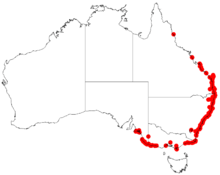Scaevola calendulacea
Scaevola calendulacea known as the dune fan-flower, is a small shrub found on sand dunes in eastern and southern Australia.[5][6]
| Dune fan-flower | |
|---|---|
 | |
.jpg) | |
| Scientific classification | |
| Kingdom: | Plantae |
| Clade: | Tracheophytes |
| Clade: | Angiosperms |
| Clade: | Eudicots |
| Clade: | Asterids |
| Order: | Asterales |
| Family: | Goodeniaceae |
| Genus: | Scaevola |
| Species: | S. calendulacea |
| Binomial name | |
| Scaevola calendulacea | |
 | |
| Occurrence data from Australasian Virtual Herbarium | |
| Synonyms[3] | |
|
Goodenia calendulacea Andrews | |
It was first described in 1798 by Henry Cranke Andrews as Goodenia calendulacea,[1][4] but in 1917 was assigned to the genus, Scaevola, by George Claridge Druce.[1][2]
Description
S. calendulace is a prostrate shrub growing to 40 cm high which flowers for most of the year. The stems are covered with hairs lying forwards and flat to the stem (appressed) The leaves are entire and the leaf-blade is up to 80 mm by 27 mm wide. It flowers in terminal spikes. The blue corolla is pubescent outside and bearded inside. The ovary has two locules and the white or purplish fruit is globular and smooth.[7]
References
- "Scaevola calendulacea". Australian Plant Name Index (APNI), IBIS database. Centre for Plant Biodiversity Research, Australian Government.
- Druce, G.C. (1917) Nomenclatorial Notes: chiefly African and Australian. The Botanical Exchange Club and Society of the British Isles Report for 1916, Suppl. 2: 644
- "Scaevola calendulacea (Andrews) Druce | Plants of the World Online | Kew Science". Plants of the World Online. Retrieved 1 December 2019.
- Andrews, H.C. (1798) Repository for New, and Rare Plants 1: t. 22
- R. C. Carolin. "Scaevola calendulacea, PlantNET - NSW Flora Online, Retrieved January 31st, 2018,".
- ala.org.au. "Scaevola calendulacea, Atlas of Living Australia, Retrieved January 31st, 2018,".
- Carolin, R.C. (2017). "Scaevola calendulacea. In: Flora of Australia". profiles.ala.org.au. Australian Biological Resources Study, Department of the Environment and Energy, Canberra. Retrieved 1 December 2019.
